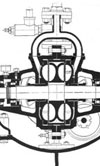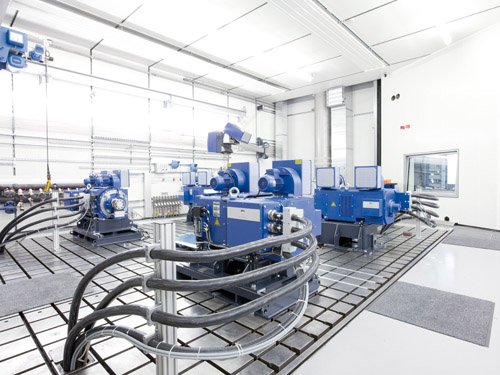Dyno-testing engines
 In general terms, a dynamometer is simply a device that can be used to measure Force or Power.
In general terms, a dynamometer is simply a device that can be used to measure Force or Power.
Power and Force are related physically. Power is defined as the rate at which we do ‘work’, whilst ‘work’, in a linear sense is the result of moving a Force through a given distance, such as lifting a weight. So, Work = Force x Distance. Since Power is defined as the Work Done per Unit Time, we can also write Power = Force x Velocity, as Velocity is the distance moved in Unit time. < /p >
When we talk of dynamometers we are often referring an engine dyno, but there are other types of dyno’s that we use on racing cars which have nothing to do with the engine, the Damper Dyno being a very common example. Here we ‘cycle’ the damper by applying a varying (usually sinusoidal) Force input, and then measure its resistance and the variation in velocity that results.
On the damper dyno we are working with linear units, Forces and linear velocities, and this is also the case when we put a car onto a chassis dynamometer, or ‘rolling road’, although we get our results in the form of bhp at the wheels. In fact what we are measuring is Tractive Effort at the wheels, which is directly related to the engine Torque through the gearing. Analogous to the relationship between Power, Force and Velocity is the following which we use for rotational motion and Torque. The relationship is usually given as Power = Torque x rpm.
Damper dyno’s are fairly common in most professional racing teams, whilst any serious engine builder will have access to an engine dynamometer, but a type of chassis dynamometer that is much less common, usually being available only to projects that have a major road car manufacturer behind them, is a combined engine and transmission dynamometer.
Here we mount the complete engine, transmission and driveline and then run the engine as if on an engine brake, whilst the software operates the clutch and transmission, the trend towards semi-automatic sequential paddle shift operated systems in recent years making this essentially a software exercise.
For many years it was often the case, particularly in endurance racing, and especially at the Le Mans 24 Hours, that the weak link in the reliability chain was not the engine, or the suspension, but the gearbox. The problem was not just that many transmissions were subject to prolonged high loading, but that much of the duty cycle consisted of shock, and reverse loads. This type of cyclic loading is often associated with metal fatigue, and this was often at the root of component failure.
A modern, sophisticated engine and transmission dyno can take, as its input, a typical duty cycle for the complete 24 hour race. This means that the engine will be throttled, on the brake, as if it were completing a lap of the circuit, the transmission will be shifted as per the requirements of the lap, and the complete driveline assembly, including driveshafts and wheel hubs will undergo this simulation over a period of perhaps 28-30 hours. This is necessary to ensure that an engine-driveline aggregate that has achieved 24 hour durability, but was about to fail after 24 hrs and 5 minutes is not signed off! There will of course be a statistical factor of safety, or in this case longevity that needs to be accounted for, in much the same way that when stressing for fatigue we look at number of cycles to failure, and then add a factor.

This type of ‘simulation’ is a subtly different use of a dyno from the typical engine test unit, in which performance is quantified, along with attempts to improve it. On the combined engine and driveline dyno the main focus is on reliability, although it can be used to assist with transient engine mapping and also is a handy tool in optimising gear change strategy.
In removing the variations in shift quality inherent in a manual gearshift, the adoption of the electro- hydraulic or pneumatic gearshift has been a big factor in improvements in gearbox reliability in recent years, but the use of the dyno, in the background, has also played a significant role.
Written by Peter Elleray.